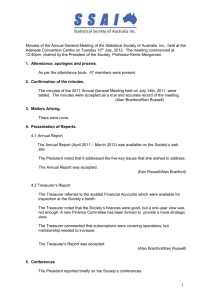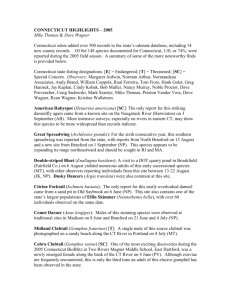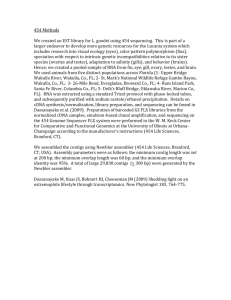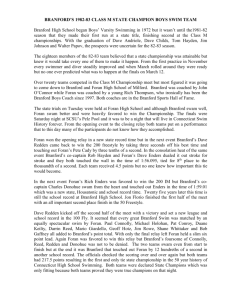Community Report Status of Branford Children
advertisement
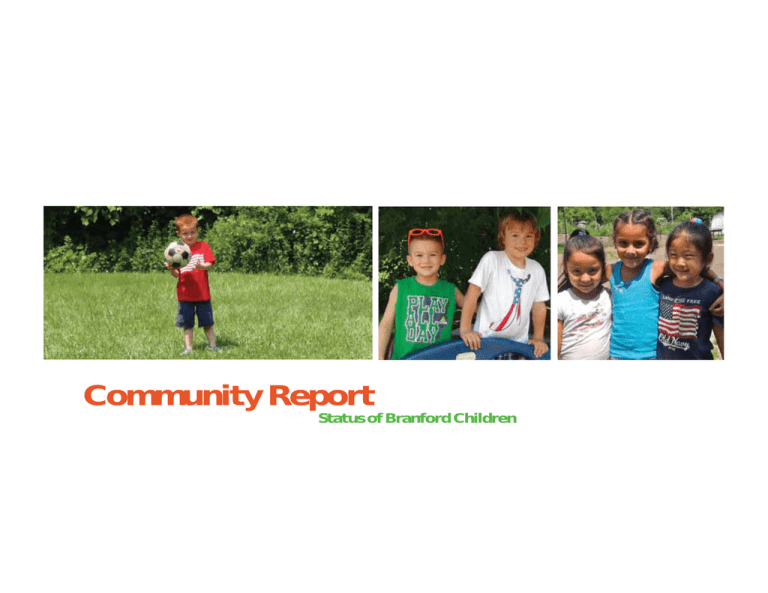
Community Report
Status of Branford Children
Why a Community Progress Report?
The community status report is meant to be an effective tool for both taking stock and prompting action. It is an accumulation of
public data on important factors inćuencing children in %ranford including demographics socioeconomic information safety health
and education.
Equal opportunity, quality resources and affordability for all, requires smart investments to support, promote, and enrich the health
and development of very young children. These coordinated efforts have lasting consequences not just for children—but for their
communities as Zell. Investment in early childhood pays dividends to local governments across time and across systems as disparate
as education health care and laZ enforcement.
Through ongoing research education and mobili]ation efforts together Ze can inform our communityès efforts toZards improving
outcomes for young children.
“Every dollar invested in quality early childhood development for disadvantaged children results
in a 7–10% return in investment through greater productivity and reduced social spending.”
-ames -. +eckman Noble Laureate in Economics
Why Young Children?
([tensive research shoZs that the early years of a childès life are most important for his or her groZth and development. Children who
are given the skills they need to successfully enter kindergarten are more likely to be reading well by age 8, less likely to drop out of
high school, and more likely to attend higher education and eventually become productive citizens. )urthermore it has been Zidely
established that signiĆcant investments in early childhood education Zill strongly reduce deĆcits and strengthen the economy. (very
dollar invested in quality early childhood development for disadvantaged children results in a return in investment through
greater productivity and reduced social spending.
Learning Begins at Birth
:e canèt Zait for %ranfordès children to enter our school system before Ze as a community begin to support their learning. Parents
DUHDFKLOGèVĆUVWDQGPRVWLPSRUWDQWWHDFKHUVDQGWKHKRPHHQYLURQPHQWSURYLGHVWKHIRXQGDWLRQIRUODQJXDJHDQGHDUO\OLWHUDF\
3arents must be connected Zith the resources they need to provide loving nurturing literacyrich homes. 2ur community must
also offer opportunities for children to have early learning e[periences through programs such as 6chool 5eadiness. $nd of course
children must be healthy—both physically and emotionally—in order to participate productively in a classroom.
1
Branford’s Dynamic Population—
Why Population Characteristics Are Important
The distribution of characteristics of the population may inćuence the
health patterns in the region and the number and type of services and
resources in the area. Like many communities, Branford is experiencing
VLJQLĆFDQWGHPRJUDSKLFFKDQJHVZKLFKSUHVHQWERWKRSSRUWXQLWLHV
and challenges. In this section Ze report the most recent data
available on key demographic indicators of race country of origin
and socioeconomic status.
%ranfordès population has decreased by appro[imately betZeen and . 'uring this period the proportion of residents Zho Zere at
least years of age increased by nearly . this affected the median
age of the toZnès population Zhich increased to years. %ranford is
becoming increasingly diverse by race ethnicity and socioeconomic
status. In %ranford . of the population is Zhite non+ispanic
and is nonZhite and non+ispanic . +ispanic . black
non+ispanic . $sian non+ispanic and . of another race or
multiracial background. The largest groZth in population increases
can be identiĆed Zith +ispanic groZth increase in last four years
folloZed by $sian and $frican $mericans.
Branford is becoming increasingly
diverse by race, ethnicity and
socio-economic status.
A Snapshot of the Branford Community & Its Families
27,988 <<
1,120 <<
1.9% <<
5.9% <<
5.9% <<
26.4% <<
9.1% <<
1624 <<
113 <<
6.7% <<
31.9% <<
5.2% <<
TABLE 1
Total population (2013) Number of children under age 5 (2010) Children under 18 who are Black or African American (2010) Children under 18 who are of Hispanic or Latino origin (2010) Percent of population foreign born (2010) Children receiving free and reduced lunch (2014-2015) Percent of population with less High School Diploma (2010) Number of households receiving SNAP (2014) Number of children 0-4 years of age living in poverty (2010) Percent of population speaking a language other than English in the home (2010) School breakfast participation rate (2014-2015) Unemployment rate (2015) SOURCE:
86 &ensus %ureau &T 'epartment of 6ocial 6ervices &T 'epartment of (ducation%ranford 3ublic 6chools &T 'epartment of /abor 2
Distribution of Wealth
&onnecticut is the Zealthiest state in the 8nited 6tates of $merica Zith a per capita income compared to %ranford at . Branford rates 59th amongst 169 Connecticut towns, with a median household income of $70,640 compared to the state of
Connecticut at $67,740. 1evertheless %ranfordès ranking represents huge disparities from coastal to inland inhabitants that can be
seen in Ćgure beloZ.
Income Distribution (Branford, CT)
FIGURE 1
$67,740
Income greater than 200K
Income between 150K & 200K
100K & 150K
0('I$1 +286(+2/' I1&20( I1 &211(&TI&8T
75K & 100K
60K & 75K
$70,640
50K & 60K
40K & 50K
30K & 40K
20K & 30K
0('I$1 +286(+2/' I1&20( I1 %5$1)25'
15K & 20K
Income less than 15K
0%
2%
4%
6%
8%
10% 12% 14% 16% 18%
SOURCE: $ll data is from the 8nited 6tates &ensus and the $merican &ommunity 6urvey <ear (stimates.
Branford’s Dynamic Population—
Socioeconomic Data
)ormerly knoZn as ê)ood 6tampsë the 6upplemental 1utrition
$ssistance 3rogram 61$3 helps loZ income families to purchase
food. 61$3 cases are measured by êassistance unitsë Zhich are
roughly comparable to households and can include multiple recipients
Zho prepare and eat food together. The data in Ćgure indicates
the number of êhouseholdsë receiving 61$3 in %ranford. $VĆJXUH
2 illustrates, SNAP recipients have increased 71% since 2010.
SNAP Households
FIGURE 2
2000
1500
1406
1508
1624
1235
1000
960
500
0
2010
2011
2012
2013
2014
SOURCE: &T 'epartment of 6ocial 6ervices
3
Number of families receiving TANF
The T$1) Temporary $ssistance for 1eedy )amilies program
operated by the &onnecticut 'epartment of 6ocial 6ervices '66
provides assistance to loZincome families Zith children and
pregnant Zomen meeting speciĆc eligibility criteria. TANF is
funded through a federal grant given to states to run their own
welfare program that is combined with State funds. T$1) cases
are measured by êassistance unitsë Zhich are roughly comparable
to households and is considered a êshort termë assistance Zith
many rules which ensure that there are no long term clients.
FIGURE 3
150
100
500
0
2010
2011
2012
2013
2014
Free & Reduced Lunch
Grade K
FIGURE 4
Grade 1
Grade 2
SOURCE: &T 'epartment of 6ocial 6ervices
30%
Free & Reduced Lunch
28%
In the 2014-2015 school year, 26.4% of Branford students
(K-4) were eligible for free and reduced lunch. )urther to this
%ranford has seen a increase in free and reduced lunch
since . (ligibility indicates students from families whose
total income is at or below percent of the poverty level.
+ousehold income below percent of the poverty level
qualiĆes students for free meals. +ousehold income between
and percent of the poverty level qualiĆes students
for reducedprice meals. )igure investigates eligibility for
free and reduced lunch in %ranford for children in
grades ..
26%
44%
I1&5($6( I1 )5(( $1' 5('8&(' /81&+ 6I1&( 24%
22%
20%
18%
16%
14%
12%
10%
2009
2010
2011
2012
2013
2014
SOURCE: &T 'epartment of (ducation %ranford 3ublic 6chools
New in the past year…
1. USDA’s Summer Meals Initiative of Branford.
2. The school breakfast program, initiated in 2013, had a 31.9% participation rate in 2014-2015.
3. Feed Branford Kids, a voluntary elementary weekend food program served 70 children in 2014-2015.
4
Parenting that Supports Healthy Development and Learning
Total Number of Substantiated Cases
FIGURE 5
2014
2013
2012
3arents and caregivers make sure children are healthy and safe equip them with the skills and resources to succeed as
adults and transmit basic cultural values to them. Parents and caregivers offer their children love, acceptance, appreciation,
encouragement, and guidance. They provide the most intimate context for the nurturing and protection of children as they
develop their personalities and identities and also as they mature physically cognitively emotionally and socially.
Substantiated Abuse and Neglect Reports
2011
)igure investigates substantiated abuse and neglect reports in %ranford that have increased in the past years.
6ubstantiated cases represent all individual allegations of abuse andor neglect contained in an accepted report where
the investigation resulted in a Ćnding of reasonable cause to believe that neglect andor abuse had occurred. 2f the cases
submitted to the authorities there was a substantiation rate of in or in cases.
2010
2009
2008
2007
0
10
20
30
SOURCE: &T 'epartment of 6ocial 6ervices
Total Substantiated Allegations (2014)
FIGURE 6
Emotional Abuse
Sexual Abuse
$n increase in reporting could be correlated with the evolution of the ê0andated 5eporting 5equirementsë that have
expanded the criteria in reporting. 1evertheless this does not explain the high substantiation rate. $ccording to the
'epartment of &hildren and )amily 6ervices '&) there is a strong correlation between the increase in substantiated
cases with an increase in mobility and larger family si]e. +istorically '&) receives the highest amount of reports during
the school year through referrals from the school system. $ODUPLQJO\WKHPDMRULW\RIWKHVHFDVHVDUHĆYHDQGVL[\HDU
olds who have recently entered the formal school system.
$s the Ćgure indicates over of the substantiated abuse and neglect cases were categori]ed as
physical neglect. $ccording to '&) examples of physical neglect are
>> Failure to provide adequate food, shelter, and clothing appropriate to the climatic and environmental conditions
>> Failure to provide, whether intentional or otherwise, supervision or a reliable person(s) to provide child care
>> Leaving a child alone for an excessive period of time given the child’s age and cognitive abilities
>> Holding the child responsible for the care of siblings or others where beyond the child’s ability
>> The person responsible for the child’s care displays erratic or impaired behavior
>> The person responsible for the child’s care is unable to consistently perform the minimum of child-caring tasks
Physical Neglect
>> Death
3arents who are living in stressful êtoxicë environments are more likely to abuse andor neglect their children.
Parents who are connected with services and supports are much less likely to commit neglect and abuse.
Physical Abuse
Medical Neglect
(arly Physical $buse and /ater 9iolent 'elinquency $ Prospective /ongitudinal 6tudy. /asford et al.
5
3.8%
14.6%
6.2%
%I5T+6 T2 02T+(56 /(66 T+$1 /$T( 25 12 P5(1$T$/ &$5(
SOURCE: &T 'epartment of Public +ealth %I5T+6 :(I*+T < *5$06
SOURCE: &T 'epartment of Public +ealth 1.7% — 2.7%
6.8% — 9.2%
2.8% — 4.4%
Too few events to produce reliable rates
4.5% — 6.7%
Healthy Babies, Healthy Branford
Preterm and low birth weight births are important predictors of infant survival child development and wellbeing. Preterm birth is the
leading cause of infant deaths accounting for approximately of infant deaths in the 8nited 6tates. Infants born prematurely are also
at risk for neurological disabilities respiratory conditions or developmental delays. Preterm birth costs the US $26 billion annually.
The risk for infant morbidity and mortality increases with lower birth weight which is associated with gestational age. At the time of the
DPH report, 6.2% of singleton births were low birth weight (<2500 grams) and 3.8% were teen moms in Branford. )rom to combined preterm birth was more heavily concentrated in and around :aterbury +artford and 1ew +aven and in 1orthern areas
in &onnecticut. The towns that experienced the greatest proportion of low birth weight births from to combined included
+artford :aterbury 1ew +aven %ridgeport their surrounding towns and towns.
6
HUSKY
+86.< $ (nrollment reports the enrollment of young children in the +86.< $ health insurance program.
+86.< $ 0edicaid is &onnecticutès public health coverage program providing free health insurance to eligible
individuals. Of those Branford children enrolled in HUSKY A, 77.5% had taken part in a least one well-child
visit. )urther to this . had enrolled in dental care. )inally . had at least one developmental screening.
466
&+I/'5(1 (152//(' I1 +86.<
77.5%
&+I/'5(1 (152//(' I1 +86.< :+2 +$'
$T /($6T 21( :(//&+I/' 9I6IT $*(6 59.4% 11.4%
&+I/'5(1 (152//(' I1 +86.<
:+2 +$' '(1T$/ &$5( $*(6 &+I/'5(1 (152//(' I1 +86.< :+2 +$' $T /($6T
21( '(9(/2P0(1T$/ 6&5((1I1* $*(6 SOURCE: 'epartment of 6ocial 6ervices provides +86.< Program data to &onnecticut 9oices for &hildren for analysis New in the past year…
The East Shore District Health Department’s federally funded Nurturing Families Network (formerly
MIECHV) was expanded to service Branford at-risk families, using the Parents As Teachers Model, an
evidence-based home visiting program. In 2014 and 2015 the MIECHV program served 8 families.
Family Center Services of Ct., of New Haven, also serves Branford and is a prevention program for
at-risk families referred from Yale New Haven Hospital has served 5 Branford families over the same
time period. These two intervention programs combined represent additional opportunities for at-risk
families to develop important parenting skills.
All mothers who receive WIC subsidies now have access to books, The Children’s Resource Guide,
health and literacy resources, as well as information on local playgroups and parent activities.
The Branford Healthy Smiles Initiative has developed a dentist referral process through the Branford
Counseling Center for children who need dental care and has made 13 referrals from Oct. 2014 to
June 2015.
HUSKY A (Medicaid)
is Connecticut’s public
health coverage
program, providing
free health insurance
to eligible individuals.
7
Kindergarten Entrance Inventory
5esearch indicates that the ability to read by third grade is a key determinant of future success in school and in life. 6cientists at +arvardès
&enter on the 'eveloping &hild assert that early experiences determine whether a childès developing brain architecture provides a strong
or weak foundation for all future learning behavior and health.
$s noted above there is growing awareness that literacy starts at birth not when a child enters school. 1or does learning for literacy
happen only through a childès interaction with teachers. Rather, a child’s learning begins at birth and encompasses relationships with
parents, other children, school personnel, and community members.
The Kindergarten entrance inventory is a subjective test that gathers information about the academic skill and behavior of kindergartners.
6ix domains of early childhood development are collected language skills literacy skills numeracy skills physicalmotor skills creative
aesthetic skills and personalsocial skills. Performance in each domain is measured from levels through with level indicating that the
student requires minimal additional support. $s Ćgure indicates nearly in children entering kindergarten in %ranford do not
have the literary skills needed to participate in kindergarten without additional support. $s Ćgure indicates over in students require
more than minimal support in language and literacy.
Branford Kindergarten Entrance Inventory (2011-2012)
FIGURE 7
SOURCE: &T 'epartment of (ducation Level 3
5equires minimal instructional support
Level 2
5equires some amount of instructional support
Level 1
100
5equires substantial degree of instructional support
80
60
New in the past year…
40
The Town of Branford and the Board of Education has
taken a critical step in acknowledging the importance
of early childhood development with its securing of a
5-year School Readiness grant through the CT OfĆce of
Early Childhood.
20
0
Physical/
Motor
Personal/
Social
Numeracy
Literacy
Language
Creative/
Aesthetic
With this grant, the Town of Branford has received state
funding to expand preschool opportunities for 13 families
living below the poverty line.
8
English Language Learners in Branford
%ranford Public 6chools has experienced a ćuctuating (//
(nglish /anguage /earning population over the past years.
$s of -une (// students enrolled in %ranford Public
6chools spoke languages other than (nglish. Further to
this, the ELL population is transient with over a quarter of its
SRSXODWLRQKDYLQJHQWHUHGDIWHUWKHĆUVWGD\RIVFKRRO
Presently certiĆed T(62/ Teacher of (nglish to 6peakers of
2ther /anguages teachers and paraprofessionals are
supporting the (// students. Title III consolidated grants
average a year and go directly to personnel to support
the (62/ (nglish for 6peakers of 2ther /anguages population.
Number of ELL Students
FIGURE 8
2014
2013
2012
2011
2010
2009
2008
0
50
100
150
SOURCE: %ranford Public 6chools
New in the past year…
Branford Public Schools has identiĆed the trending data and has hired an additional TESOL
teacher and to continue the outreach to community members. This is conducted through
a multi-pronged approach and in collaboration with East Shore Regional Adult Continuing
Education, (ERACE).
200
40
180%(5 2) /$1*8$*(6
2T+(5 T+$1 (1*/I6+
%(I1* 6P2K(1 I1
%5$1)25' P8%/I& 6&+22/6
SOURCE: %ranford Public 6chools 9
Branford’s Performance Gap
Throughout the United States and Connecticut, low-income and minority children are not performing as well as their higher-income
peers. This difference in performance is referred to as the ê$chievement *ap.ë &onnecticut has the highest achievement gap in the nation
which has put our public school system at a crossroads. The test scores of our lowincome students are signiĆcantly lower than the stateès
non lowincome students. This occurs despite the fact that our students overall score among the top Ćve states in national math and
reading tests. Taking action to help close this gap needs to be an economic and moral imperative for our state. )igure investigates test scores of %ranford third graders comparing test scores of those who are receiving free and reduced lunch and those who do not.
Third Grade CMT Scores at Goal or Above (2012)
Writing
69.2
41.3
FIGURE 9
Reading
76.3
47.5
Math
87.4
62.2
Children who are not
reading proĆciently
by third grade have
a four times greater
chance of not
graduating on time.
Full Price Lunch
Free & Reduced Lunch
SOURCE: &T 'epartment of (ducation New in the past year…
The Branford Public School System has recently completed a District Strategic Success Plan that
prioritized the performance gap through careful data analysis at the district, school, and classroom level.
T+I6 :$6 0$'( P266I%/( %<
“A timely report that should be used as a starting point to rally the community around its
youngest citizens and most precious resource. I look forward to the next steps…”
0r. +amlet +ernande] Superintendent of Schools
“This document should be the catalyst for setting attainable goals and objectives to meet
the health and development needs of Branford children.”
-ames %. &osgrove First Selectman
T+$1K <28
0eredith *affney the project $ccountability &oordinator 5obin &omey &oordinator of
%ranford (arly &hildhood &ollaborative and 'r. Kate 0arsland for her special consultation help.
$''ITI21$/ T+$1K6
%ranford &ounseling &enter %ranford Police 'epartment %ranford :I& and &onnecticut
'epartment of <outh )amilies )irst 6electman -amie &osgrove 6uperintendent +amlet
+ernande] and %(&&ès (xecutive :ork *roup.
6P(&I$/ T+$1K6
The *reater 1ew +aven &ommunity )oundation and the :illiam &aspar *raustein 0emorial
Fund for making this project possible.
All data are publicly available and current to June 2015. “New in past year” are a sampling of community programs
designed to address gaps and are not meant to be an exhaustive list of programs addressing the needs of children.
Concept + Design : www.joshcodesign.com
